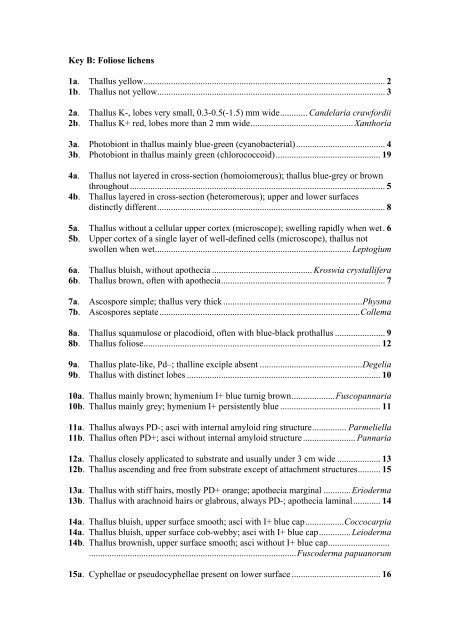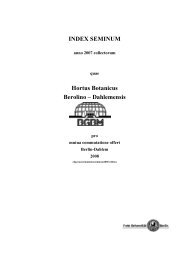Keys to the macrolichens and checklist of the lichens and ...
Keys to the macrolichens and checklist of the lichens and ...
Keys to the macrolichens and checklist of the lichens and ...
You also want an ePaper? Increase the reach of your titles
YUMPU automatically turns print PDFs into web optimized ePapers that Google loves.
Key B: Foliose <strong>lichens</strong><br />
1a. Thallus yellow.......................................................................................................... 2<br />
1b. Thallus not yellow.................................................................................................... 3<br />
2a. Thallus K-, lobes very small, 0.3-0.5(-1.5) mm wide............ C<strong>and</strong>elaria crawfordii<br />
2b. Thallus K+ red, lobes more than 2 mm wide............................................. Xanthoria<br />
3a. Pho<strong>to</strong>biont in thallus mainly blue-green (cyanobacterial)....................................... 4<br />
3b. Pho<strong>to</strong>biont in thallus mainly green (chlorococcoid).............................................. 19<br />
4a. Thallus not layered in cross-section (homoiomerous); thallus blue-grey or brown<br />
throughout................................................................................................................ 5<br />
4b. Thallus layered in cross-section (heteromerous); upper <strong>and</strong> lower surfaces<br />
distinctly different.................................................................................................... 8<br />
5a. Thallus without a cellular upper cortex (microscope); swelling rapidly when wet. 6<br />
5b. Upper cortex <strong>of</strong> a single layer <strong>of</strong> well-defined cells (microscope), thallus not<br />
swollen when wet...................................................................................... Lep<strong>to</strong>gium<br />
6a. Thallus bluish, without apo<strong>the</strong>cia ............................................ Kroswia crystallifera<br />
6b. Thallus brown, <strong>of</strong>ten with apo<strong>the</strong>cia........................................................................ 7<br />
7a. Ascospore simple; thallus very thick .............................................................Physma<br />
7b. Ascospores septate........................................................................................Collema<br />
8a. Thallus squamulose or placodioid, <strong>of</strong>ten with blue-black prothallus ...................... 9<br />
8b. Thallus foliose........................................................................................................ 12<br />
9a. Thallus plate-like, Pd–; thalline exciple absent .............................................Degelia<br />
9b. Thallus with distinct lobes ..................................................................................... 10<br />
10a. Thallus mainly brown; hymenium I+ blue turnig brown...................Fuscopannaria<br />
10b. Thallus mainly grey; hymenium I+ persistently blue ............................................ 11<br />
11a. Thallus always PD-; asci with internal amyloid ring structure............... Parmeliella<br />
11b. Thallus <strong>of</strong>ten PD+; asci without internal amyloid structure ....................... Pannaria<br />
12a. Thallus closely applicated <strong>to</strong> substrate <strong>and</strong> usually under 3 cm wide ................... 13<br />
12b. Thallus ascending <strong>and</strong> free from substrate except <strong>of</strong> attachment structures.......... 15<br />
13a. Thallus with stiff hairs, mostly PD+ orange; apo<strong>the</strong>cia marginal ............Erioderma<br />
13b. Thallus with arachnoid hairs or glabrous, always PD-; apo<strong>the</strong>cia laminal............ 14<br />
14a. Thallus bluish, upper surface smooth; asci with I+ blue cap.................Coccocarpia<br />
14a. Thallus bluish, upper surface cob-webby; asci with I+ blue cap..............Leioderma<br />
14b. Thallus brownish, upper surface smooth; asci without I+ blue cap...........................<br />
...........................................................................................Fuscoderma papuanorum<br />
15a. Cyphellae or pseudocyphellae present on lower surface ....................................... 16




